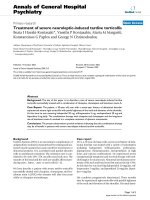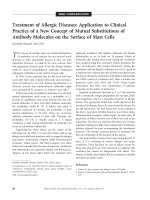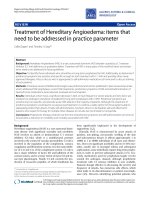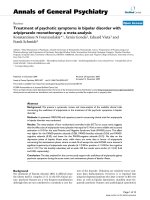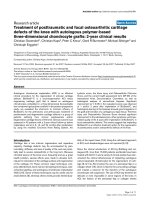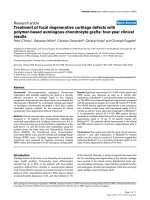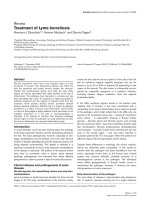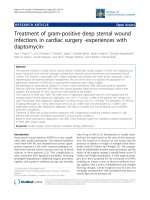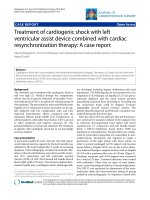Báo cáo y học: "Treatment of stasis dermatitis using aminaphtone: Benign giant mediastinal schwannoma presenting as cardiac tamponade in a woman: a case report" ppsx
Bạn đang xem bản rút gọn của tài liệu. Xem và tải ngay bản đầy đủ của tài liệu tại đây (457.44 KB, 3 trang )
CAS E REP O R T Open Access
Benign giant mediastinal schwannoma
presenting as cardiac tamponade in a woman:
a case report
Motoyasu Kato
1
, Satomi Shiota
1*
, Kazuo Shiga
1
, Haruhi Takagi
1
, Hiroaki Mori
1
, Mitsuaki Sekiya
1
, Kenji Suzuki
2
,
Toshimasa Uekusa
3
, Kazuhisa Takahashi
1
Abstract
Introduction: Mediastinal schwannomas are typically benign and asymptomatic, and generally present no
immediate risks. We encountered a rare case of a giant benign posterior mediastinal schwannoma, complicated by
life-threatening cardiac tamponade.
Case presentation: We report the case of a 72-year-old Japanese woman, who presented with cardiogenic shock.
Computed tomography of the chest revealed a posterior mediastinal mass 150 cm in diameter, with pericardial
effusion. The cardiac tamponade was treated with prompt pericardial fluid drainage. A biopsy was taken from the
mass, and after histological examination, it was diagnosed as a benign schwannoma, a well-encapsulated non-
infiltrating tumor, originating from the intrathoracic vagus nerve. It was successfully excised, restoring normal
cardiac function.
Conclusion: Our case suggests that giant mediastinal schwannomas, although generally benign and
asymptomatic, should be excised upon discovery to prevent the development of life-threatening cardiopulmonary
complications.
Introduction
Mediastinal schwannomas are typically benign and
asymptomatic, and generally present no immediate risks.
We encountered a rare case of a giant benign posterior
mediastinal schwannoma that was complicated by life-
threatening cardiac tamponade.
Case presentation
A 72-year-old Japanese woman presented at the emer-
gency room with cardiogenic shock and hypoxia. She
reported the presence of exercise-induced dyspnea and
right chest pain for several weeks. Her history included
discovery two years previously of a posterior mediastinal
tumor, 130 mm in diameter; be cause she was asympto-
matic, our patient had declined further detailed exami-
nation and treatment at the time.
On physical examination, we found our patient’ sskin
to be diaphoretic. She had a s ystolic blood pressure of
80 mmHg b y palpation, atrial fibrillation with a heart
rate of 130 beats/minute, and no detectable paradoxical
pulse. She had severe hypoxia with an oxygen saturation
level of 85% on 100% oxygen at 10 litres/min. Cardio-
genic shock was strongly suspected.
Laboratory values for blood coagulation and blood cell
counts were normal. Chest radiography showed an
enlarged heart with hypolucent areas in both lung fields,
and bilateral pleural effusion (Figure 1a). Computed
tomography of t he chest revealed a sha rply marginated
tumor, 150 mm in size, in the posterior mediastinum,
and pericardial effusion (Figure 1b). Echocardiography
showed a large pericardial effusion with diastolic c ol-
lapse of the right side of the heart, indicating cardiac
tamponade, and prompting us to carry out pericardial
drainage.
A total of 1200 ml of cloudy fluid was aspirated,
which was analyzed and found to contain 4.8 g/dl of
total protein, 3941 cells/μl, with an erythrocyte volume
* Correspondence:
1
Department of Respiratory Medicine, School of Medicine, Tokyo, Japan
Full list of author information is available at the end of the article
Kato et al. Journal of Medical Case Reports 2011, 5:61
/>JOURNAL OF MEDICAL
CASE REPORTS
© 2011 Kato et al; licensee BioMed Central Ltd. This is an Open Access article distributed under the terms of the Creative Commons
Attribution License ( g/licenses/by/2.0), which perm its unrestricted use, distribution, and reproduction in
any medium, pro vided the original work is properly cited.
fraction of 11.6%, implying that it was exudate fluid.
Lymphocytes were the dominant cell type without any
evidence of malignant cells. The fluid was classified as
class II cytology. Bacterial and fungal cultu res produced
no growth.
A transcutaneous ultrasound-guided biopsy of the
tumor was obtained, and the histological findings were
consistent with a benign schwannoma. Magnetic reso-
nance imaging of the chest after pericardial drainage
showed that the tumor occupied the posterior mediasti-
num of the left pleural cavity, and was clearly sep arated
from the cardiac structures (Figure 1c,d).
Complete surgical resection was carried out using a
left thoracotomy approach, and the mass was found to
be a giant tumor, 140 × 100 mm in size, originating
from the vagus nerve(Figure 2a). Although adhering
broadly to part of the parietal epicardium, lower left
lobe of lung, diaphragm and descending aorta, and
being fully decorticated, the well encapsulated tumor
had not infiltrated the adjacent organs or the pericar-
dium. Histological examination showed that the tumor
was consistent with a benign schwannoma, characterized
by a proliferation of spindle cells with cellular unifor-
mity and immunoreactivity to S-100 protein (Figure 2d).
Our patient was discharged on the sixth postoperative
day, and had an uneventful recovery.
Discussion
This was a rare case of a benign posterior mediastinal
schwannoma, originating from the vagus ner ve, compli-
cated by life-threatening cardiac tamponade. Schwanno-
mas are benign nerve sheath neoplasms of Schwann cell
origin, and are the most common of the neurogenic
mediastinal tumors. Nearly 45% of schwannomas occur
in the head and neck, with 9% occurring in the medias-
tinum [1]. Generally, mediastinal schwannomas are
slow-growing and asymptomatic and rarely degenerate
into malignant tumors. The origin of our patient’s
tumor is atypical in that it stemmed from the intrathor-
acic branches of the vagus nerve. Mediastinal schwanno-
mas most frequently arise in a paravertebral location
from sympathetic trunks or intercostal nerves [2,3].
Schwannomas originating from the vagus nerve within
the mediastinum are rare, comprising only 1.4% of
intrathoracic schwannomas [4].
The hemodynamic clinical course of our patient was
also unusual, as there are few reported cases of schwan-
nomas with cardiac involvement. Two cases of benign
tumors in the ventricle epicardium involving pericardial
effusion have been described [5,6], and two further cases
were reported as malignant intrapericardial schwanno-
mas with cardiac tamponade [7,8].
To the best of our knowledge, this is the first reported
case of a benign extrapericardial mediastinal schwan-
noma presenting with life-t hreatening cardiac tampo-
nade caused by a large volume of pericardial effusion.
Previous reported cases of malignant meidiastinal
Figure 1 Lung imaging. (a) Chest radiograph obtained on the day
of hospital admission showing bilateral pleural effusion, mediastinal
widening and cardiac enlargement. (b) Contrast-enhanced chest
computed tomography image (lung window) taken during
pericardial drainage, showing a giant posterior mediastinal tumor,
pericardial effusion and bilateral pleural effusion. (c) Transversal
T1-weighted magnetic resonance imaging (MRI) scan of the chest
taken after pericardial drainage, showing a giant encapsulating
tumor in the posterior mediastinum compressing the heart. (d)
Sagittal True SSFP (steady state free precession) MRI image, showing
the tumor occupies most of left thoracic cavity.
Figure 2 Macro and Histological images.(a) Macro findings of an
encapsulated solid tumor measuring 140 mm at its the greatest
dimension. The cut surface was smooth with a pale yellow color,
and showed numerous mucinous foci without extracapsular
invasion. Microscopically, the tumor exhibited (b) Antoni A areas
composed of ill-defined fascicles of spindle cells and (c) loosely
organized Antoni B areas. (d) Immunohistochemically, the tumor
cells were strongly positive for S-100 protein.
Kato et al. Journal of Medical Case Reports 2011, 5:61
/>Page 2 of 3
schwannoma presenting as cardiac tamponade in Reck-
linghausen’s disease had a rapidly fatal outcome after
pericardial drainage, whereas in our case, drainage pro-
duced rapid restoration of normal cardiac function as
measured by echocardiography, with no recurrent fluid
accumulation after complete excision of the tumor.
Cardiac tamponade can be induced by either slow or
rapid accumul ation of pericar dial fluid. With slow accu-
mulation, the volume can become quite large and s till
cause no symptoms [9,10]. Thus, we believe that the
fluid accumulation in our patient developed over a long
period of time, and that the cardiac tamponade was not
caused by the tumor directly infiltrating or perforating
the cardiac tissue. Our patient was not anemic on
admission, indicating no significant hemorrhage during
her clinical course. In the case of chronic idiopathic
pericardial effusion, fibrosis or inflammatory cell infiltra-
tion has been reported [11] as a change in pericardial
histology. In our patient, the chronic pericardial inflam-
mation induced by the giant mediastinal schwannoma
occupying the posterior mediastinum of the left pleural
cavity might have induced similar histological changes
and thickening of the pericardium. It is possible that the
thickened pericardium impairs fluid re-absorption, and
the high colloid osmotic pressure of the pericardium
fluid increases the tendency to fluid accumulation,
Although giant mediastinal schwannomas are usually
benign, this case suggests that they can become life-
threatening and thus should be aggressively and completely
resected once discovered to prevent cardiopulmonary com-
plications. Likewise, in cases of cardiac emergencies, the
possible p resence of large benign mediastinal s chwannomas
or other tumors should be investigated.
Conclusions
In conclusion, w e report a rare case of a giant benign
posterior mediastinal schwannoma, originating from the
vagus nerve, presenting with life-threatening cardiopul-
monary complications of significant pericardial effusion
leading to cardiac tamponade. Immediate drainage and
complete surgical excision of the tumor successfully
restored normal cardiac function and hemodynamic sur-
gical intervention of benign giant posterior mediastinal
schwannomas is recommended in similar cases to pre-
vent the occurrence of cardiac tamponade.
Consent
Written informed consent was obtained fro m our
patient for publication of this case report and any
accompanying images. A copy of the written consent is
available for review by the Editor-in-Chief of this
journal.
Author details
1
Department of Respiratory Medicine, School of Medicine, Tokyo, Japan.
2
Department of General Thoracic Surgery Juntendo University, School of
Medicine, Tokyo, Japan.
3
Department of Pathology Kanto Rosa Hospital,
Kanagawa, Japan.
Authors’ contributions
MK and SS reviewed the clinical data and were major contributors in writing
the manuscript. KS, HT, HM and KT were involved with patient management.
MS performed the histological examination of the biopsy. KS was our
patient’s attending surgeon and provided information on our patient. TU
analyzed histological data and performed the immunohistochemical analysis.
All authors read and approved the final manuscript.
Competing interests
The authors declare that they have no competing interests.
Received: 5 June 2010 Accepted: 14 February 2011
Published: 14 February 2011
References
1. Das Gupta TK, Brasfield RD: Benign solitary Schwannomas
(neurilemomas). Cancer 1969, 24(2):355-66.
2. Strollo DC, Rosado-de-Christensonml , Jett JR: Primary mediastinal tumors:
part II. Tumors of the middle and posterior mediastinum. Chest 1997,
112(5):1344-1357.
3. Marchevsky AM: Mediastinal tumors of peripheral nervous system origin.
Semin Diagn Pathol 1999, 16(1):65-78.
4. Heras F, Ramos G, Castanedo M, Cortejoso A, Duque JL, Yustemg :
Schwannoma of the intrathoracic vagus nerve. Arch Bronconeumol 1997,
33(7):360-2.
5. Rausche T, El-Mokthari NE, Kruger D, Herrman G, Tiroke A, Rahimi-Barfeh A,
Lins M: Benign mediastinal schwannoma: cardiac considerations - case
report and a short review of the literature. Clin Res Cardiol 2006,
95(8):422-424.
6. Preusse CJ, Schulte HD, Irlich G, Winter J: Hemodynamic cardiovascular
effects caused by mediastinal tumors. Langenbecks Arch Chir 1986,
369:149-152.
7. Bennis A, Ridai M, Nafidi S, Soulami S, Tahiri A, Chraibi N: Malignant
mediastinal schwannoma in Recklinghausen’s disease presenting as
cardiac tamponade. Report of two cases. Arch Mal Coeur Vaiss 2000,
93(4):381-384.
8. Soulami S, Chraibi S, Ait Ben Hammou C, Haddani J, Louahlia S, Chraibi N:
Mediastinal malignant schwannoma disclosed by pericardial tamponade
in von Recklinghausen disease. Ann Cardiol Angeiol (Paris) 1995,
44(8):418-421.
9. Shabetal R: Pericardial Effusion. The Pericardium New York, NY: Grune and
Stratton; 1981, 108-153.
10. Watkins MW, LeWintermm : Physiologic role of the normal pericardium.
Annu Rev Med 1993, 44:171-180.
11. Brown AK: Chronic idiopathic pericardial effusion. Br Heart J 1966,
28(5):609-614.
doi:10.1186/1752-1947-5-61
Cite this article as: Kato et al.: Benign giant mediastinal schwannoma
presenting as cardiac tamponade in a woman: a case report. Journal of
Medical Case Reports 2011 5:61.
Kato et al. Journal of Medical Case Reports 2011, 5:61
/>Page 3 of 3
